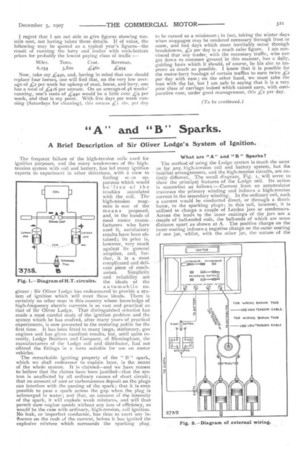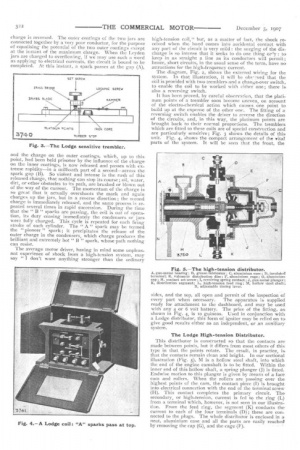" A 11 and " B " Sparks.
Page 19

Page 20

If you've noticed an error in this article please click here to report it so we can fix it.
A Brief Description of Sir Oliver Lodge's System of Ignition.
The frequent failure of the high-tension coils used for ignition purposes, and the many weaknesses of the hightension system with coil and battery, has led many ignition experts to experiment in other directions, with a view to finding sc.ile apparatus which would be'free of the troubles associated with the coil. The high-tension magneto is one of the means proposed, and, in the hands of most motor manufacturers who have used it, satisfactory results have been obtained; its price is, however, very much against its general adoption, and, further, it is a most complicated and deli
4krilii■rbyas
cate piece of mech cate piece of mech
373S. 15 anism. Simplicity and reliability are the ideals of the automobile engineer: Sir Oliver Lodge has endeavoured to provide a system of ignition which will meet those ideals. There is certainly no other man in this country whose knowledge of high-frequency electric currents is so vast and practical as that of Sir Oliver Lodge. That distinguished scientist has made a most careful study of the ignition problem and the system which he has evolved, after many years of practical experiments, is now presented to the motoring public for the first time. It has been fitted to many large, stationary, gas engines and has given excellent results, but, until quite recently, Lodge Brothers and Company, of Birmingham, the manufacturers of the Lodge coil and distributor, had not offered the fittings in a form suitable for use on motor vehicles.
The remarkable igniting property of the " B " spark, which we shall endeavour to explain later, is the secret of the whole system_ It is claimed—and we have reason to believe that the claims have been justified—that the system is unaffected by all ordinary causes of short circuit; that no amount of soot or carbonaceous deposit on the plugs can interfere with the passing of the spark; that it is even possible to pass a spark across the gap when the plug is submerged in water; and that, on account of the intensity of the spark, it will explode weak mixtures, and will thus permit slow engine speeds without any loss of efficiency, as would be the case with ordinary, high-tension, coil ignition. No leak, or imperfect conductor, has time to exert any influence on the rush of the current, before it has ignited the explosive mixture which surrounds the sparking plug.
Fig. 1.—Diagram of H.T. circuits.
What are "A" and " B " Sparks?
The method of using the Lodge system is much the same as for any,: high-tension coil and battery system, but the internal arrangements, and the high-tension circuits, are entirely different., The small diagram, Fig. t, will serve to shoW the principal features of the Lodge coil. Its action is somewhat as follows :—Current from an accumulator traverses the primary winding and induces a high-tension current in the secondary winding. In the ordinary coil, such a current would be conducted direct, or through a distributor, to the sparking plugs; in this coil, however, it is utilised to charge a couple of Leyden jars Or condensers. Across the leads to the inner coatings of the jars are a couple of ball-ended rods, the ball-ends of which are some distance apart as shown at A. The positive charge on the inner coating induces a negative charge on the outer coating of one jar, whilst, with the other jar, the nature of the charge is reversed. The outer coatings of the two jars are connected together by a very poor conductor, for the purpose of equalising the potential of the two outer coatings except at the instant of the maximum charge, When the Leyden jars are charged to overflowing, if we may use such a word as applying to electrical currents, the circuit is bound to be completed. At this instant, a spark passes at the gap (A),
and the charge on the outer coatings, which, up to this point, had been held prisoner by the influence of the charge on the inner coatings, is now released and passes with extreme rapidity—in a millionth part of a second—across the spark gap (B). So violent and intense is the rush of this released charge, that nothing can stop its course; oil, water, dirt, or other obstacles to its path, are brushed or blown out of the way of the current. The momentum of the charge is so great that it actually overshoots the mark and again charges up the jars, but in a reverse direction; the second charge is immediately released, and the same process is repeated several times in rapid succession. During the time that the " B " sparks are passing, the coil is out of operation, its duty ceasing immediately the condensers or jars were fully charged. This cycle is repeated for each firing stroke of each cylinder. The " A " spark may be termed the " pioneer " spark ; it precipitates the release of the outer charge in the condensers, which charge produces the brilliant and extremely hot " B " spark, whose path nothing can resist.
The average motor driver, having in mind some unpleasant experience of shock from a high-tension system, may say " I don't want anything stronger than the ordinary
high-tension coil," but, as a matter of fact, the shock received when the hand comes into accidental contact with any part of the circuit is very mild : the surging of the discharge is so intense that it seeks to do one thing or'y : to keep in as straight a line as its conductors will permit; hence, short circuits, in the usual sense of the term, have no attractions for the high-frequency current.
The diagram, Fig. 2, shows the external wiring for the system. In that illustration, it will be ohs' ved that the coil is provided with two tremblers and a change-over switch, to enable the coil to be worked with either one; there is also a reversing switch.
It has been proved, by careful observation, that the platinum points of a trembler soon become uneven, on account of the electro-chemical action which causes. one point to build up at the expense of the other one. The fitting of a reversing switch enables the driver to reverse the direction of the circuits, and, in this way, the platinum points are brought back to their normal proportions. The tremblers which are fitted to these coils are of special construction and are particularly sensitive ; Fig. 3 shows the details of this unit. Fig. 4, shows the compact arrangement of the vital parts of the system. It will be seen that the front, the
sides, and the top, all open and permit of the inspection of
every part when necessary. The apparatus is supplied ready for attachment to the dashboard, and may be used with any 4 or 6 volt battery. The price of the fitting, as shown in Fig. 4, is to guineas. Used in conjunction with a Lodge distributor, this form of igniter may be relied on to give good results either as an independent, or an auxiliary System.
The Lodge High-tension Distributor.
This distributor is constructed so that the contacts are made between points, but it differs from most others of this type in that the points rotate. The result, in practice, is. that the contacts remain clean and bright. In our sectional illustration (Fig. 5), M is a hollow steel shaft, into which the end of the engine camshaft is to be fitted. Within the inner end of this hollow shaft, a spring plunger (J) is fitted. Endwise motion to this plunger is given by means of a face earn and rollers. When the rollers are passing over the highest points of the cam, the contact piece (1) is brought into electrical connection with the end of the terminal screw (H). This contact completes the primary circuit. The secondary, or high-tension, current is fed to the ring (L) from a terminal which, however, is not seen in our illustration. From the feed ring, the segment (K) conducts the current to each of the four terminals (D); these are connected to the plugs. The whole distributor is enclosed in a neat, aluminium case and all the parts are easily reached by removing the cap (G), and the cage (F).






















